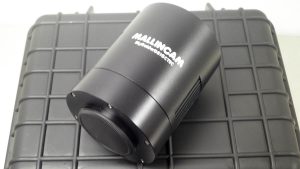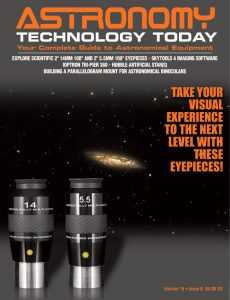The MallinCam DS16cTEC has been designed from the ground up to accommodate the most demanding wide field astronomical video imaging applications. It features a new CMOS cooling system approach that was first debuted last fall in the MallinCam DS10cTEC.
The new cooling system is a result of Rock Mallin’s past work with CMOS sensors where in the vast majority of cases the sensors could not be directly cooled via a cold finger without causing damage and delamination which could ultimately shorten sensor life.
 He began working towards a new cooling system that provides no direct physical contact between the Peltier cooler and the sensor. Instead, he examined the possibility of a Peltier cooler that creates a convection system “refrigerator-like” environment that cools the sensor without actually contacting it. The result is a cooling system is unique to MallinCam cameras.
He began working towards a new cooling system that provides no direct physical contact between the Peltier cooler and the sensor. Instead, he examined the possibility of a Peltier cooler that creates a convection system “refrigerator-like” environment that cools the sensor without actually contacting it. The result is a cooling system is unique to MallinCam cameras.
The new cooling system works by cooling the DS16cTEC’s Panasonic 16MP class 1 Micro Splitter CMOS sensor via convection which reduces the potential result of thermal shock to the sensor and its associated circuitry.
This is important because CMOS sensors have other components mounted on the same wafer with the imaging section which do not require or could be adversely affected by cooling. These include the digital logic circuitry (interface, timing, processing, output amplifiers, pad rings and associated oscillators), clocks and timing controls, analog signal processing, and analog-to-digital converter (which when under cooling from direct cold finger and Peltier results in instability). These parts of the CMOS sensor do not need to be direct cooled from a cold finger application.
Taking these considerations in mind, Mallin design an alternative – a cooling chamber offering refrigeration cooling – which subjects the CMOS sensor to cooling inside a triple sealed vacuumed sensor chamber controlled with a heating element mounted around the internal optical window to control and avoid dew formation on the optical window and surroundings. The vacuumed sealed chamber eliminates the use of desiccant material and keep a dew free environment permanently.
The SkyRaider DS10cTEC and the recently introduced MallinCam DS16cTEC take advantage of this new cooling innovation and provide a new level of live astronomical viewing and astro video imaging. Each camera is built to strict laboratory specifications, where CNC machining is used throughout the process to provide the rigid tolerances needed to provide precise component matching. The chamber has six stainless steel screws securing the chamber cover under 100 pounds of pressure to avoid possible air leaks into the chamber.
The internal electronics use Grade 1 components with a tolerance of 0.5% and meet a military and aerospace standards in many of the components. The DS16cTEC contains 4Gb DDR3 internal memory to insure the smooth flow of data to the computer. It also has a built-in USB2 hub that can support a guider as well as a USB type focuser or filter wheel.
Each MallinCam DS16cTEC camera is subjected to a 24-hour burn-in prior to shipment to insuring proper operation. It is priced at 1699.99US.
Features and specifications of the DS16cTEC include:
– Free Software and Free Updates
– Convection Cooling
– Refrigeration Chamber
– Vacuumed Sealed Chamber
– Linear Cooling
– Built-in Heater for Optical Window Dew Removal and Chamber Temperature Control
– 100 Pound Chamber Plate Pressure Held with 6- Stainless Steel Screws
– Built-In USB2 Hub for Guider, Focuser, Filter Wheel, Etc.
– Four Blue LED Status Indicators (Power, System, Cooler, Fan)
– High velocity Ultra Quiet Fan with Dual Air Output
– High Grade Carrying Case
– T Mount, (2″ Adapter Included)
– Digital Binning of 1×1, 2×2, 3×3, 4×4
– Class 1 Sensor
– Global Shutter
– 8 and 12 Bits Selectable
– BPM Calculation Technology Requiring Only 1/16 of Memory Usage
– Star Registration System for Live Stacking on the Fly
– Ideal for Motorized Alt-Az Mounted Telescopes
– Image Format: FITS, JPEG, BMP, PNG
– Video Format: SER and AVI
– Dark Field Subtraction on the Fly
– Flat Field Correction
– Support and Includes Video Mode and Trigger Mode
– Built-in DDR Memory
– CDS (Correlated Double Sampling)
– 16.3 Mega Pixels Panasonic CMOS Ceramic Color Sensor
– 22mm diagonal
– 17.5mm Back Focus
– Number of Effective Pixels – 4656 X 3518
– Transfer Method: All-pixel Scan
– Progressive Scan
– Read Noise 1.2e @40db Gain (Mono Version)
– Full Well is 20ke
– Full HD Support
– Hand Selected Sensor Class 1 Scientific Grade
– Sealed Multi-Coated No IR Optical Window
– Pixel (μm): 3.80 X 3.80 Square
– Connectivity USB 3.0 (USB2 Compatible at a Reduced Data Transfer Rate)
– Two Cable Operation
– No Need for an External Power Supply
– Sensor Gain: Variable Up to 20x
– Sensor G Sensitivity: 2413mv @ 1/30s
– Binning Resolution: 4640 X 3506, 2304 X 1750, 1536 X 1168
– Sensor: Panasonic v Maicovicon Series Class 1 Astronomical Grade CMOS Sensor
– Full Scan, Any Size Cropping
– Aspect Ratio: 4:3
– Total Number of Pixels: 16,845,920
– Guiding: ST4 Standard Protocol
– All Aluminum Construction, Precision CNC Machining
– Hand Crafted Electronics Assembly
– Weight: 530 Grams (18.65 oz)
– Dimension: 10.0 cm X 8.00 cm (3.93 Inches X 3.14 inches)
– One USB 3 Cable Operation
– 5 meter (15.5 feet) Premium USB3 Cable
– Carrying Case Included
– T-Mount to 2″ Adapter Included
– AC Power supply Included
 And to make it easier for you to get the most extensive telescope and amateur astronomy related news, articles and reviews that are only available in the magazine pages of Astronomy Technology Today, we are offering a 1 year subscription for only $6! Or, for an even better deal, we are offering 2 years for only $9. Click here to get these deals which only will be available for a very limited time. You can also check out a free sample issue here.
And to make it easier for you to get the most extensive telescope and amateur astronomy related news, articles and reviews that are only available in the magazine pages of Astronomy Technology Today, we are offering a 1 year subscription for only $6! Or, for an even better deal, we are offering 2 years for only $9. Click here to get these deals which only will be available for a very limited time. You can also check out a free sample issue here.

